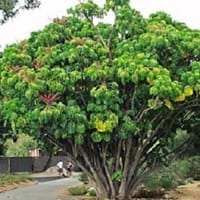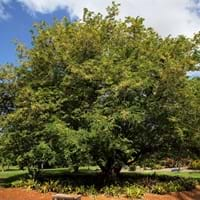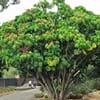Life Span
Perennial
Perennial
Origin
Melanesia, Australia
Africa, India, Southeast Asia
Types
Umbrella plant
Amate
Sweet Tamarind, Australian tamarind, Manila tamarind, Velvet tamarind, Spanish Tamarind
Number of Varieties
Not Available
Habitat
gardens, Homesteads, Roadsides, Tropical regions, Woods
Subtropical climates, Tropical regions
USDA Hardiness Zone
10-15
9-11
AHS Heat Zone
12-9
Not Available
Sunset Zone
H1, H2, 23, 24
Not Available
Habit
Upright/Erect
Spreading
Flower Color
Red, Pink
Red, Yellow
Flower Color Modifier
Bicolor
Bicolor
Fruit Color
Red, Purple
Brown
Leaf Color in Spring
Green, Light Green
Green
Leaf Color in Summer
Green, Light Green
Dark Green, Green
Leaf Color in Fall
Green, Light Green
Dark Green, Yellow green
Leaf Color in Winter
Red, Purple
Dark Brown, Green
Leaf Shape
Elliptic
Pinnate
Plant Season
Spring, Summer, Fall, Winter
Spring, Summer, Fall, Winter
Sunlight
Full Sun, Partial Sun, Partial shade
Full Sun, Partial Sun
Type of Soil
Loam, Sand
Clay, Loam, Sand
The pH of Soil
Acidic, Neutral, Alkaline
Acidic
Soil Drainage
Average
Average
Bloom Time
Summer, Late Summer, Early Fall, Fall, Late Fall
Late Spring
Tolerances
Pollution, Soil Compaction
Drought, Salt
Where to Plant?
Ground
Ground
How to Plant?
Seedlings, Transplanting
Layering, Seedlings, Transplanting
Plant Maintenance
Medium
Low
Watering Requirements
Do Not over Water, Keep the ground moist but not water-logged, Water occasionally
Do Not over Water, Keep the ground moist but not water-logged
In Summer
Lots of watering
Lots of watering
In Spring
Moderate
Moderate
In Winter
Average Water
Average Water
Soil pH
Acidic, Neutral, Alkaline
Acidic
Soil Type
Loam, Sand
Clay, Loam, Sand
Soil Drainage Capacity
Average
Average
Sun Exposure
Full Sun, Partial Sun, Partial shade
Full Sun, Partial Sun
Pruning
Remove damaged leaves, Remove dead branches, Remove dead leaves
Remove damaged leaves, Remove dead branches, Remove dead leaves
Fertilizers
All-Purpose Liquid Fertilizer
6-6-6 or 8-8-8
Pests and Diseases
Red blotch
Aphids, Borers, Mealybugs, Onion thrips, Root weevil, Soft scales, Whiteflies
Plant Tolerance
Drought
Drought
Flower Petal Number
Single
Single
Foliage Texture
Coarse
Bold
Foliage Sheen
Glossy
Matte
Attracts
Birds
Beetles, Birds, Scale Insects
Allergy
Dermititis
Diarrhea, Hives, Nausea, Vomiting
Aesthetic Uses
Showy Purposes
Beautification
Beauty Benefits
Not Available
Glowing Skin, Good for skin, Improve skin tone, Reduces ageing, Skin cleanser
Environmental Uses
Air purification
Food for animals, Food for birds, Food for insects, Nesting sites for birds
Medicinal Uses
Arthritis, Asthma, Headache, Rheumatoid arthritis, Stomach pain
Antioxidants, Inflammation, Rheumatism, Skin Disorders, Sore throat
Part of Plant Used
Root
Flowers, Fruits, Leaves
Other Uses
Employed in herbal medicine, Showy Purposes
Culinary use, Used as a nutritious food item, Used as Ornamental plant, Used for its medicinal properties
Used As Indoor Plant
No
No
Used As Outdoor Plant
Yes
Yes
Garden Design
Container, Feature Plant, Houseplant, Screening / Wind Break, Street Trees, Tropical
Edible, Fruit / Fruit Tree, Shade Trees
Botanical Name
SCHEFFLERA actinophylla
Tamarindus indica
Common Name
Octopus Tree
Tamarind tree, Tamarind
In Hindi
ऑक्टोपस पेड़
इमली का पेड़
In German
Octopus tree
Tamarinde
In French
arbre Octopus
tamarinier
In Spanish
árbol pulpo
tamarindo
In Greek
χταπόδι δέντρο
δέντρο Tamarind
In Portuguese
Octopus árvore
tamarindo
In Polish
Ośmiornica drzewo
drzewo tamaryndowca
In Latin
polypus ligno
tamarind ligno
Phylum
Magnoliophyta
Magnoliophyta
Class
Magnoliopsida
Magnoliopsida
Family
Araliaceae
Fabaceae
Genus
Schefflera
Tamarindus
Clade
Angiosperms, Asterids, Eudicots
Angiosperms, Eudicots, Rosids
Tribe
Not Available
Detarieae
Subfamily
Aralioideae
Caesalpinioideae
Number of Species
Not Available
Not Available
Season and Care of Octopus Tree and Tamarind tree
Season and care of Octopus Tree and Tamarind tree is important to know. While considering everything about Octopus Tree and Tamarind tree Care, growing season is an essential factor. Octopus Tree season is Spring, Summer, Fall and Winter and Tamarind tree season is Spring, Summer, Fall and Winter. The type of soil for Octopus Tree is Loam, Sand and for Tamarind tree is Clay, Loam, Sand while the PH of soil for Octopus Tree is Acidic, Neutral, Alkaline and for Tamarind tree is Acidic.
Octopus Tree and Tamarind tree Physical Information
Octopus Tree and Tamarind tree physical information is very important for comparison. Octopus Tree height is 610.00 cm and width 460.00 cm whereas Tamarind tree height is 1,800.00 cm and width 800.00 cm. The color specification of Octopus Tree and Tamarind tree are as follows:
Octopus Tree flower color: Red and Pink
Octopus Tree leaf color: Green and Light Green
Tamarind tree flower color: Red and Yellow
- Tamarind tree leaf color: Green
Care of Octopus Tree and Tamarind tree
Care of Octopus Tree and Tamarind tree include pruning, fertilizers, watering etc. Octopus Tree pruning is done Remove damaged leaves, Remove dead branches and Remove dead leaves and Tamarind tree pruning is done Remove damaged leaves, Remove dead branches and Remove dead leaves. In summer Octopus Tree needs Lots of watering and in winter, it needs Average Water. Whereas, in summer Tamarind tree needs Lots of watering and in winter, it needs Average Water.





